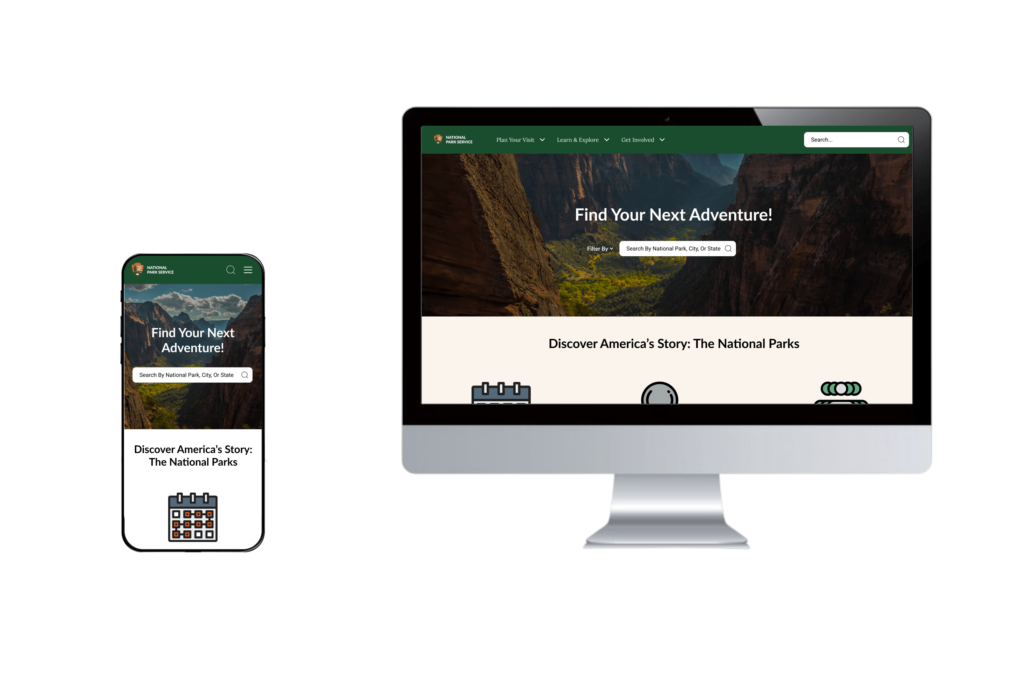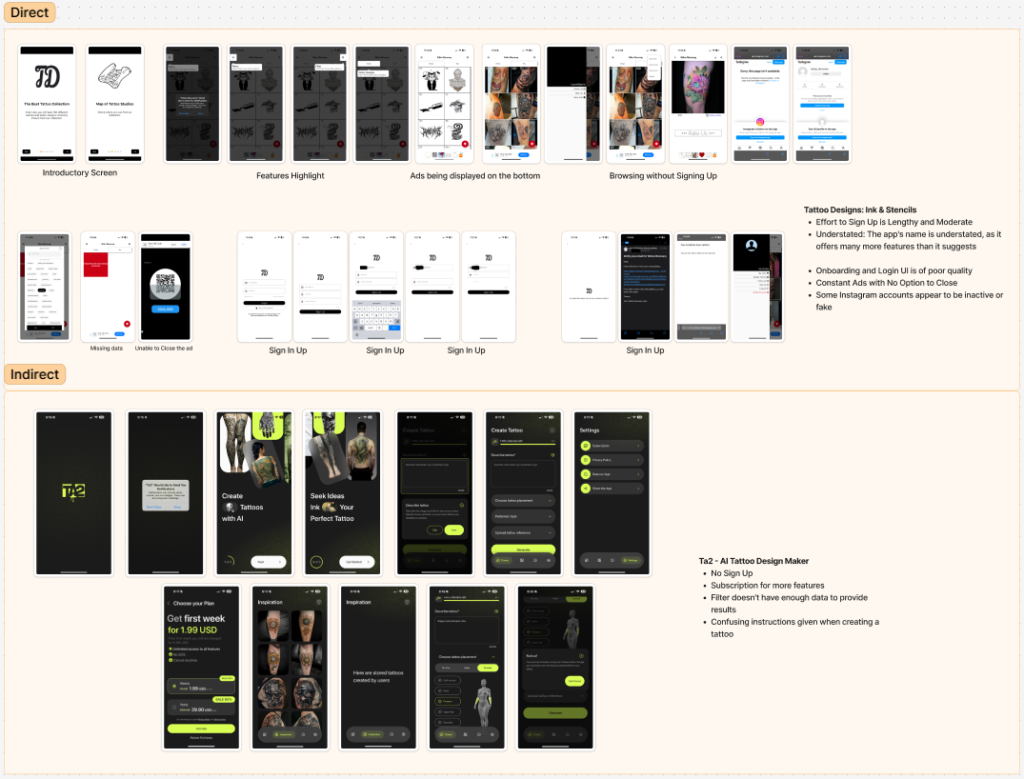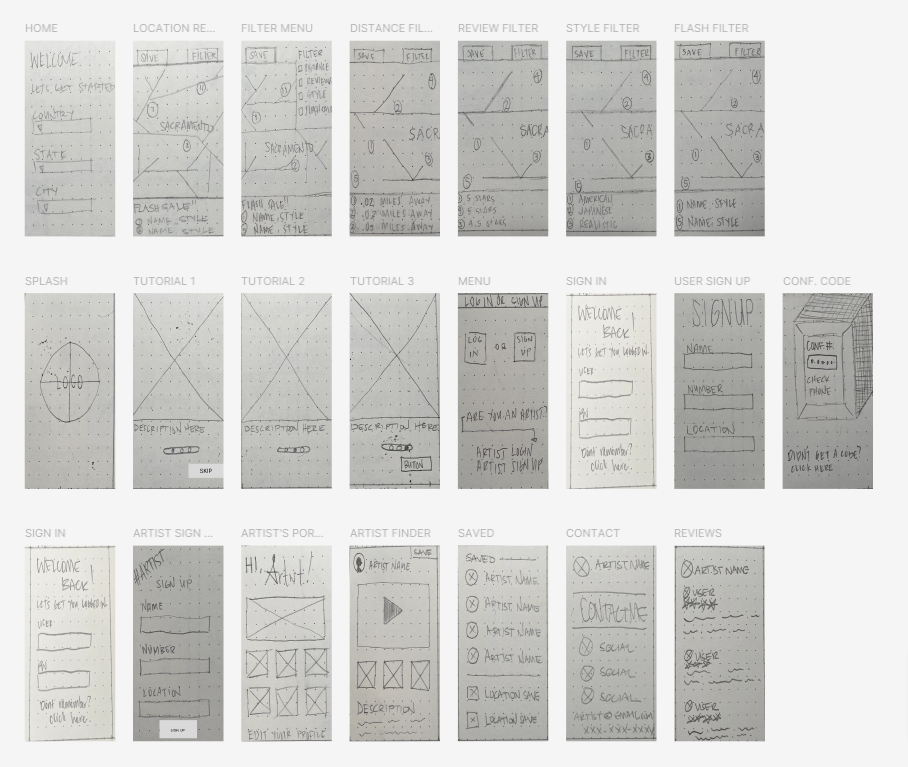Designing a Global Platform to Connect Users with Tattoo Artists
Enhancing Usability, Trust, and Artist Discovery for a Worldwide Audience
Role: UX Researcher/Designer
Tools: Figma, Google Suite, Zoom
Duration: May 2024 - June 2024 (3 Weeks)
The Challenge
The goal was to design a comprehensive platform connecting users with tattoo artists globally, addressing issues of trust, accessibility, and artist discovery. Users faced challenges in finding artists that matched their style, reviewing portfolios in a reliable way, and feeling confident about their tattoo choices. The need for an intuitive and engaging experience was paramount.
The Solution
In this UC Berkeley Extension project, I collaborated with a team to conduct user research, competitive analysis, and usability testing, which informed a streamlined design that connected users with artists based on style, location, and trustworthiness. I focused on creating user flows, wireframes, and high-fidelity prototypes that emphasized ease of use, artist transparency, and strong user-artist connections.

Results & Impact
Enhanced Discoverability
Created user flows and search filters that made it easy for users to find tattoo artists by location, style, and availability, greatly improving artist visibility.
User Trust & Transparency
Designed detailed artist profiles with portfolios, reviews, and style tags, which fostered trust and helped users make confident decisions.
Streamlined User Experience
Developed an intuitive, visually engaging interface that guided users seamlessly through the process of finding, evaluating, and connecting with tattoo artists.
Scroll down to dive deeper into the process
Process Overview
1. Research
Conducted user interviews and competitive analysis to identify user needs and market gaps, focusing on trust, style discovery, and ease of connection.
2. Define
Established project goals to prioritize user trust, seamless navigation, and the ability to search artists by style, location, and availability.
3. Ideation
Created low-fidelity wireframes and user flows, outlining a straightforward process for discovering and connecting with tattoo artists.
4. Design
Developed high-fidelity prototypes, refining the interface to ensure an intuitive, visually appealing experience that fostered user-artist connections.
Research & Insights
Research Objective
The goal was to uncover users' motivations, pain points, and expectations when connecting with tattoo artists. Insights gathered from user interviews and Instagram polls guided the design of the Tattoo Finder app, ensuring it met user needs for trust, convenience, and personalization.
User Interviews
I conducted in-depth interviews with five participants between the ages of 20 and 45, all with experience in locating or booking tattoo artists. Additionally, an Instagram poll gathered broader data on tattoo preferences and expectations. These findings helped shape a design that meets user needs and builds trust.
Key Findings
- Trust and Safety: Users prioritize trust in their tattoo artist, valuing face-to-face interactions to assess professionalism and hygiene.
- Connection and Style Matching: Users seek artists who align with their personal style and appreciate detailed portfolios.
- Booking Challenges: Users often face difficulties booking appointments due to location constraints, artist availability, and lengthy wait times.
- Personalization: Many users desire specific features, like filtering by location, style, and reviews, to simplify the search for the right artist.
How These Insights Guided Design
- Trust-Building Features: Added filters for verified reviews and portfolio visibility, allowing users to gauge artist credibility.
- Personalization Options: Introduced style and location-based filters to streamline the search experience.
- Ease of Communication: Integrated messaging options for pre-booking conversations, enhancing user confidence in booking.
Turning Data into Priorities & Insights
As part of the user research phase, we used various methods to prioritize features and functionalities that align with the needs of tattoo clients and artists. By developing a Priority Matrix, conducting an Affinity Map analysis, and gathering feedback through the I Like, I Wish, and What If exercise, we identified the most impactful solutions to build trust and streamline artist discovery. Additionally, a Competitor Analysis provided valuable insights into market gaps, guiding us in creating a unique, user-centered platform that addresses common pain points in connecting with tattoo artists.
Priority Matrix
Mapping priorities based on user needs and project goals allowed us to focus on impactful features like artist reviews, filtering, and location-based search. This matrix ensured we addressed critical areas that influence user satisfaction and trust.

Affinity Map
Organizing insights into themes clarified user preferences, driving the prioritization of features like filtering options and verified reviews. These insights reinforced the need for features that build user confidence.

I Like, I Wish, and What If
This feedback format brought forward user desires for transparency, virtual interactions, and flexible booking. Incorporating this feedback helped us design a more responsive and user-friendly experience.

Competitor Feature Analysis
Provide a quick overview of the analysis of direct and indirect competitors, highlighting key insights on user pain points with existing tattoo apps and areas where Tattoo Finder can differentiate itself.

Turning Data into Personas & Journeys
After gathering in-depth user insights, I synthesized this information into key components: personas, empathy mapping, journey mapping, and user feedback. Each step helped shape Tattoo Finder’s design, ensuring that it met user expectations and streamlined the process from discovery to booking.
Zenya Robinson - User Persona
Zenya’s persona represents users who value connection and trust with tattoo artists. This guided our focus on transparent artist profiles and personalized interactions to foster a sense of safety and reliability.

Empathy Maps
Understanding Zenya's thoughts, feelings, and actions emphasized the need for clear communication and reassurance throughout her journey. It shaped our design to be empathetic, addressing her pain points and fostering confidence.

User Journey Map
Detail each step of Zenya’s interaction with the app, emphasizing her emotions, expectations, and opportunities for improvement throughout her experience, from initial discovery to the booking confirmation.

Storyboard
Illustrate Zenya's journey visually, from her motivation to find a tattoo artist for a meaningful design to her discovery of Tattoo Finder and the benefits of the app’s filtering and booking options.

User Flow
Illustrate the app’s core user flow, breaking down the steps Zenya takes to discover artists, filter by preferences, view portfolios, and finalize her booking. This section will demonstrate the app’s logical and intuitive navigation designed for efficiency and ease.

Turning Insights into Statements
User Insight Statement
Users like Zenya often face challenges in finding tattoo artists they trust, with specific expertise and style preferences. They value transparency, online presence, and a streamlined way to explore portfolios, book appointments, and ensure safety and professionalism. This process can feel daunting without effective search and filtering tools.
How Might We?
How might we design an app that simplifies the process of discovering and connecting with tattoo artists by offering personalized search options, comprehensive artist portfolios, and reliable user reviews, so users like Zenya feel empowered and confident in their choice?
User Impact Statement
By creating an app that allows users to filter by style, location, and reviews, and that emphasizes trust-building elements like artist profiles and user testimonials, Tattoo Finder enables users like Zenya to make informed choices. This approach enhances user satisfaction, fosters artist-client connections, and encourages positive, safe tattoo experiences.
Mockups & Iteration Process
From the insights gathered during research, I understood that users like Liam needed an easy, intuitive way to access park information and plan their visits. They prioritized simplicity, visual appeal, and seamless navigation without overwhelming content. To address these needs, I developed a series of mockups, starting with low-fidelity wireframes and progressing to high-fidelity prototypes, both for mobile and desktop versions. The iterative design process involved creating clear, user-friendly layouts that guided users towards essential actions like trip planning and trail exploration. Throughout each iteration, I refined the user experience by incorporating feedback, ensuring the final design was engaging, accessible, and aligned with the National Park Service’s mission. Throughout the iteration process, I ensured the design featured strategically placed calls-to-action (CTAs) that guided users seamlessly through the site, building trust and reducing barriers to engagement.
Lo-fi Mockups

Hi-Fi Mockups (Mobile)

Final Design
he final design of the Tattoo Finder app provides a user-centered, visually cohesive, and intuitive experience, shaped by research insights and iterative refinement. A bold color palette and streamlined typography enhance readability and maintain aesthetic appeal across the interface, while interactive elements such as clear filter options and intuitive navigation guide users seamlessly through artist profiles and booking options. Each design choice supports Tattoo Finder's mission to simplify the search and connection process for tattoo enthusiasts, creating a trusted platform that emphasizes safety, professionalism, and user empowerment.
What I Learned
This project highlighted the significance of user-centered design in crafting an intuitive and trustworthy platform that helps users find tattoo artists who match their style and needs.
Through user research and testing, I gained insight into translating user preferences into practical features, emphasizing transparency, and fostering a sense of connection between users and artists. Working in a team, I refined my approach to iterative design, prioritizing accessibility and clarity, ensuring each interaction felt genuine and supportive.
Working independently, I embraced the iterative process, using each research insight to refine the design and solve real user challenges. This experience reinforced my belief in the power of design to not only enhance user experience but also foster a deeper connection to the mission of the organization—in this case, inspiring people to connect with nature.
The Impact I Made
1. Developed a user-centered app concept that connects users with tattoo artists, enhancing trust and convenience.
2. Simplified the artist discovery and booking process with clear navigation, tailored filters, and accessible information.
3. Enhanced the user journey with detailed artist profiles and portfolio features, fostering informed decision-making.
4. Created a design that balances functionality and aesthetics, aligning with user expectations and industry standards.
5. Contributed to a seamless, visually engaging prototype that prioritizes both user empowerment and safety in the tattoo booking experience.
